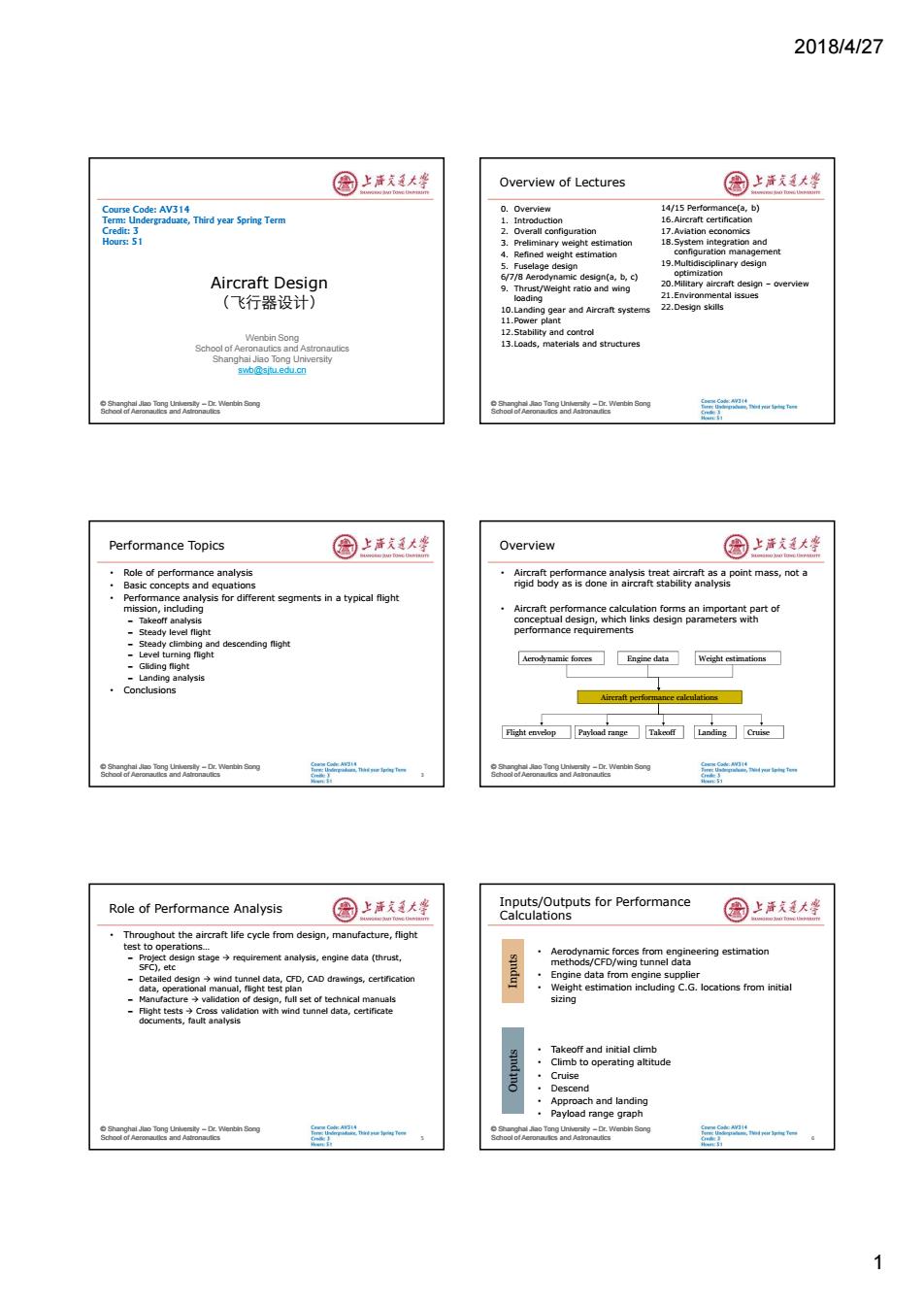
2018/4/27 国上活大坐 Overview of Lectures 国上清大学 Course Code:AV314 0.Overview 14/15 Performance(a,b) Term:Undergraduate,Third year Spring Term 16.Aircraft certification Credit:3 2.Overall configuration 17.Aviation economics Hours:51 weight estimation 18.System integration and d weight estimation configuration management Fuselage design 19.Multidisciplinary design 6/7/8 Aerodynamic design(a,b,c) ootimization Aircraft Design (飞行器设计) .hat and ing 20.Military aircraft design-overview 21.Environmental issues 10.Landing gear and Aircraft systems 22.Design skills 11.Power plant Wenbin Song 12.Stability and control School of Aeronautics and Astronautics 13.Loads,materials and structures Shanghai Jiao Tong University swb@sjtu.edu.cn ertin ong Song Performance Topics 圆上清文大些 Overview 国上道大坐 Role of performance analysis Aircraft performance analysis treat aircraft as a point mass,not a Basic concepts and equations rigid body as is done in aircraft stability analysis analysis for different segmentsin a typical flight mission, -Takeoff analysis Airra perfomancer of a -Steady level flight -Steady climbing and descending flight -Level turning flight Gliding flight Acrodynamic fores Engine data Weight estimations -Landina analysis ·Conclusions Aircraft performance calculations itevop☐Payload range☐Takooff Landing Cruise 8oaoT二Wenbin ong Role of Performance Analysis 图上洋大峰 Inputs/Outputs for Performance Calculations 园上海发大坐 Throughout the aircraft life cycle from design,manufacture,flight test to ope Pret)etc sign stagerequirement analysis,engine data(thrust, Engine data from engine supplier Weight estimation including C.G.locations from initial -Manufacture validation of design,full set of technical manuals sizing Flight testsCross validation with wind tunnel data,certificate documents,fault analysis Takeoff and initial climb Climb to operating altitude ·Cruise Descend Approach and landing ·Payload range graph sy-Dr.Wenbin Song 1
2018/4/27 1 © Shanghai Jiao Tong University – Dr. Wenbin Song School of Aeronautics and Astronautics Wenbin Song School of Aeronautics and Astronautics Shanghai Jiao Tong University swb@sjtu.edu.cn Aircraft Design (飞行器设计) Course Code: AV314 Term: Undergraduate, Third year Spring Term Credit: 3 Hours: 51 © Shanghai Jiao Tong University – Dr. Wenbin Song School of Aeronautics and Astronautics Overview of Lectures 0. Overview 1. Introduction 2. Overall configuration 3. Preliminary weight estimation 4. Refined weight estimation 5. Fuselage design 6/7/8 Aerodynamic design(a, b, c) 9. Thrust/Weight ratio and wing loading 10.Landing gear and Aircraft systems 11.Power plant 12.Stability and control 13.Loads, materials and structures 14/15 Performance(a, b) 16.Aircraft certification 17.Aviation economics 18.System integration and configuration management 19.Multidisciplinary design optimization 20.Military aircraft design – overview 21.Environmental issues 22.Design skills © Shanghai Jiao Tong University – Dr. Wenbin Song School of Aeronautics and Astronautics Performance Topics • Role of performance analysis • Basic concepts and equations • Performance analysis for different segments in a typical flight mission, including – Takeoff analysis – Steady level flight – Steady climbing and descending flight – Level turning flight – Gliding flight – Landing analysis • Conclusions 3 © Shanghai Jiao Tong University – Dr. Wenbin Song School of Aeronautics and Astronautics Overview • Aircraft performance analysis treat aircraft as a point mass, not a rigid body as is done in aircraft stability analysis • Aircraft performance calculation forms an important part of conceptual design, which links design parameters with performance requirements Aerodynamic forces Engine data Weight estimations Aircraft performance calculations Flight envelop Payload range Takeoff Landing Cruise © Shanghai Jiao Tong University – Dr. Wenbin Song School of Aeronautics and Astronautics Role of Performance Analysis • Throughout the aircraft life cycle from design, manufacture, flight test to operations… – Project design stage requirement analysis, engine data (thrust, SFC), etc – Detailed design wind tunnel data, CFD, CAD drawings, certification data, operational manual, flight test plan – Manufacture validation of design, full set of technical manuals – Flight tests Cross validation with wind tunnel data, certificate documents, fault analysis 5 © Shanghai Jiao Tong University – Dr. Wenbin Song School of Aeronautics and Astronautics Inputs/Outputs for Performance Calculations • Aerodynamic forces from engineering estimation methods/CFD/wing tunnel data • Engine data from engine supplier • Weight estimation including C.G. locations from initial sizing • Takeoff and initial climb • Climb to operating altitude • Cruise • Descend • Approach and landing • Payload range graph 6 Inputs Outputs
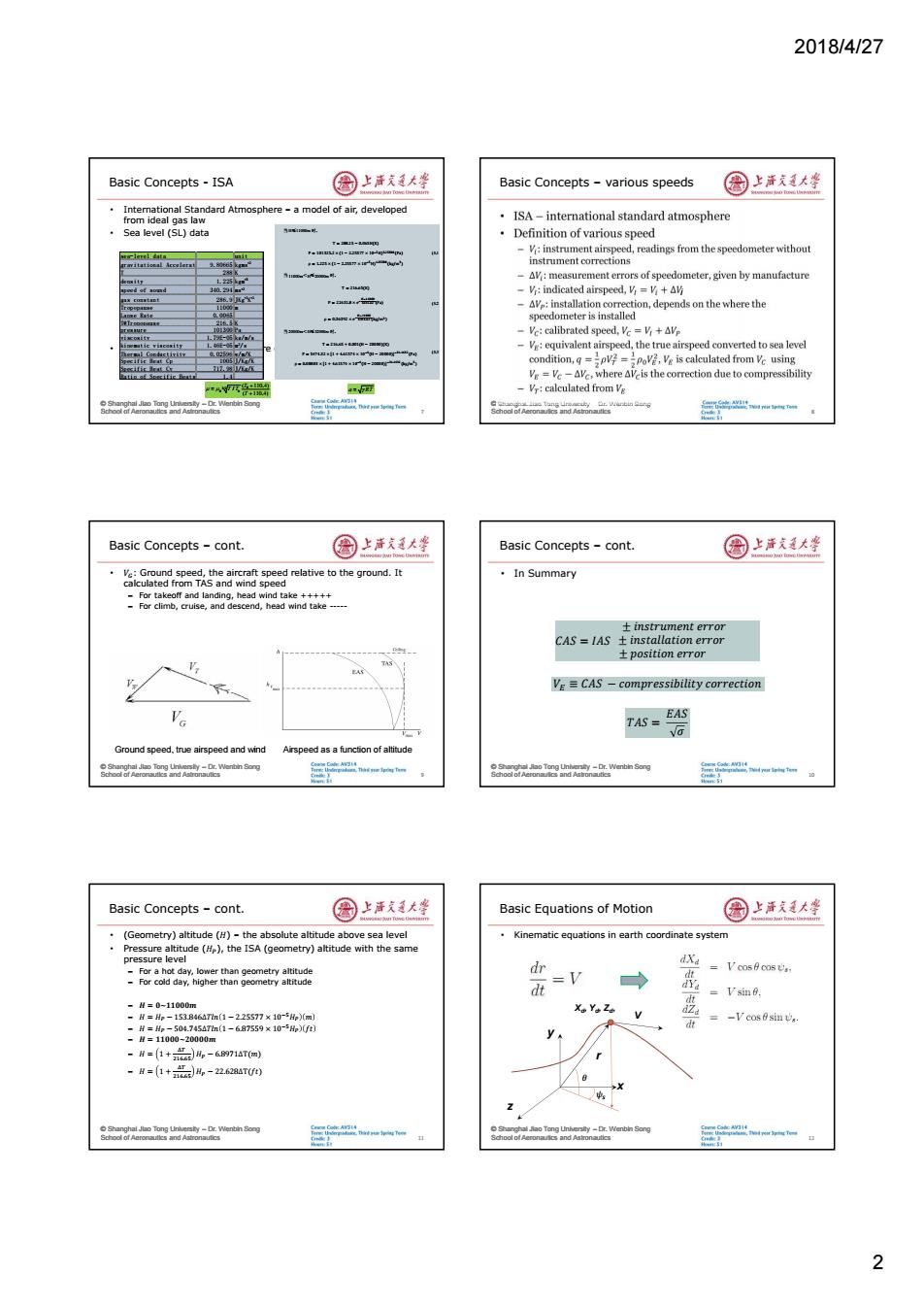
2018/4/27 Basic Concepts-ISA 国上活大坐 Basic Concepts-various speeds 国上清大学 International Standard Atmosphere-a model of air,developed from ideal gas law ISA-international standard atmosphere Sea level(SL)data Definition of various speed 。 -instrument airspeed,readings from the speedometer without Li-2ih instrument corrections -AV:measurement errors of speedometer,given by manufacture -V:indicated airspeed,V=V+AV -AVp:installation correction,depends on the where the speedometer is installed -Vc:calibrated speed,Vc=V+AVe 士 -Ve:equivalent airspeed,the true airspeed converted to sea level n+ condition,g=ov?=pove,Ve is calculated from Vc using Ve=Vc-AVc,where AVcis the correction due to compressibility :5冠 -Vr:calculated from Ve Basic Concepts-cont. 圈上活大坐 Basic Concepts -cont. 国上清大坐 Ve:Ground speed,the aircraft speed relative to the ground.It ·In Summary calculated from TAS and wind speed For takeoff and landing,head wind take++++ For climb,cruise,and descend,head wind take---- 土im.strument error CAS IAS t installation error ±position error Ve CAS compressibility correction Va TAS= EAS G Ground speed,true airspeed and wind Airspeed as a function of altitude oornWen on 10 Basic Concepts-cont. 图上洋大峰 Basic Equations of Motion 国上清大学 。 (Geometry)altitude (H)-the absolute altitude above sea level Kinematic equations in earth coordinate system Pressure altitude(H),the ISA(geometry)altitude with the same pressure level dXa -For a hot day,lower than geometry altitude dr -For cold day,higher than geometry altitude dt =V V cos6 cos a Vsin. =H=0-11000m -H=h-153B46a1-22557×10-5H0m XoYoZo =-V cos 0sin ta. y -H=(1+总)-689714T网)) -H=(1+)4-22.628△T) sty-Dr.Wenbin Song y-Dr.Wenbin Song 2
2018/4/27 2 © Shanghai Jiao Tong University – Dr. Wenbin Song School of Aeronautics and Astronautics Basic Concepts - ISA • International Standard Atmosphere – a model of air, developed from ideal gas law • Sea level (SL) data • Viscosity and speed of sound are given as 7 sea-level data unit gravitational Acceleration 9.80665 kgms-2 T 288 K density 1.225 kgm-3 speed of sound 340.294 ms-2 gas constant 286.9 JKg-1K-1 Tropopause 11000 m Lapse Rate 0.0065 T@Tropopause 216.5 K pressure 101300 Pa viscosity 1.79E-05 kg/m/s kinematic viscosity 1.46E-05 m2 /s Thermal Conductivity 0.02596 w/m/K Specific Heat Cp 1005 J/Kg/K Specific Heat Cv 717.98 J/Kg/K Ratio of Specific Heats 1.4 当 H≤11000m 时, T = 288.15 − 0.065H(K) P = 101325.2 × (1 − 2.25577 × 10−5H)5.25588 (Pa) ρ = 1.225 × (1 − 2.25577 × 10−5H)4.25588 (kg/m3 ) (5.1 当 11000m<H≤20000m 时, T = 216.65(K) P = 22631.8 × e− 𝐻−11000 6341.62 (Pa) ρ = 0.36392 × e− 𝐻−11000 6341.62 (kg/m3 ) (5.2 当 20000m<H≤32000m 时, T = 216.65 + 0.001(H − 20000)(K) P = 5474.32 × [1 + 4.61574 × 10−6(H − 20000)]−34.1632 (Pa) ρ = 0.08803 × [1 + 4.61574 × 10−6 (H − 20000)]−34.1632 (kg/m3 ) (5.3 a RT 3/2 0 0 0 ( 110.4) / ( 110.4) T T T T © Shanghai Jiao Tong University – Dr. Wenbin Song School of Aeronautics and Astronautics Basic Concepts – various speeds 8 i © Shanghai Jiao Tong University – Dr. Wenbin Song School of Aeronautics and Astronautics Basic Concepts – cont. • 𝑉ீ: Ground speed, the aircraft speed relative to the ground. It calculated from TAS and wind speed – For takeoff and landing, head wind take +++++ – For climb, cruise, and descend, head wind take ----- 9 Ground speed, true airspeed and wind Airspeed as a function of altitude © Shanghai Jiao Tong University – Dr. Wenbin Song School of Aeronautics and Astronautics Basic Concepts – cont. • In Summary 10 𝐶𝐴𝑆 = 𝐼𝐴𝑆 ± 𝑖𝑛𝑠𝑡𝑟𝑢𝑚𝑒𝑛𝑡 𝑒𝑟𝑟𝑜𝑟 ± 𝑖𝑛𝑠𝑡𝑎𝑙𝑙𝑎𝑡𝑖𝑜𝑛 𝑒𝑟𝑟𝑜𝑟 ± 𝑝𝑜𝑠𝑖𝑡𝑖𝑜𝑛 𝑒𝑟𝑟𝑜𝑟 𝑉ா ≡ 𝐶𝐴𝑆 − 𝑐𝑜𝑚𝑝𝑟𝑒𝑠𝑠𝑖𝑏𝑖𝑙𝑖𝑡𝑦 𝑐𝑜𝑟𝑟𝑒𝑐𝑡𝑖𝑜𝑛 𝑇𝐴𝑆 = 𝐸𝐴𝑆𝜎 © Shanghai Jiao Tong University – Dr. Wenbin Song School of Aeronautics and Astronautics Basic Concepts – cont. • (Geometry) altitude (𝐻) – the absolute altitude above sea level • Pressure altitude (𝐻), the ISA (geometry) altitude with the same pressure level – For a hot day, lower than geometry altitude – For cold day, higher than geometry altitude – 𝑯 = 𝟎~𝟏𝟏𝟎𝟎𝟎𝒎 – 𝐻 = 𝐻 − 153.846Δ𝑇𝑙𝑛 1 − 2.25577 × 10ିହ𝐻 𝑚 – 𝐻 = 𝐻 − 504.745Δ𝑇𝑙𝑛 1 − 6.87559 × 10ିହ𝐻 𝑓𝑡 – 𝑯 = 𝟏𝟏𝟎𝟎𝟎~𝟐𝟎𝟎𝟎𝟎𝒎 – 𝐻 = 1 + ் ଶଵ.ହ 𝐻 − 6.8971ΔT(𝑚) – 𝐻 = 1 + ் ଶଵ.ହ 𝐻 − 22.628ΔT(𝑓𝑡) 11 © Shanghai Jiao Tong University – Dr. Wenbin Song School of Aeronautics and Astronautics Basic Equations of Motion • Kinematic equations in earth coordinate system 12 V r x y z Xd , Yd , Zd , 𝜃 𝜓௦
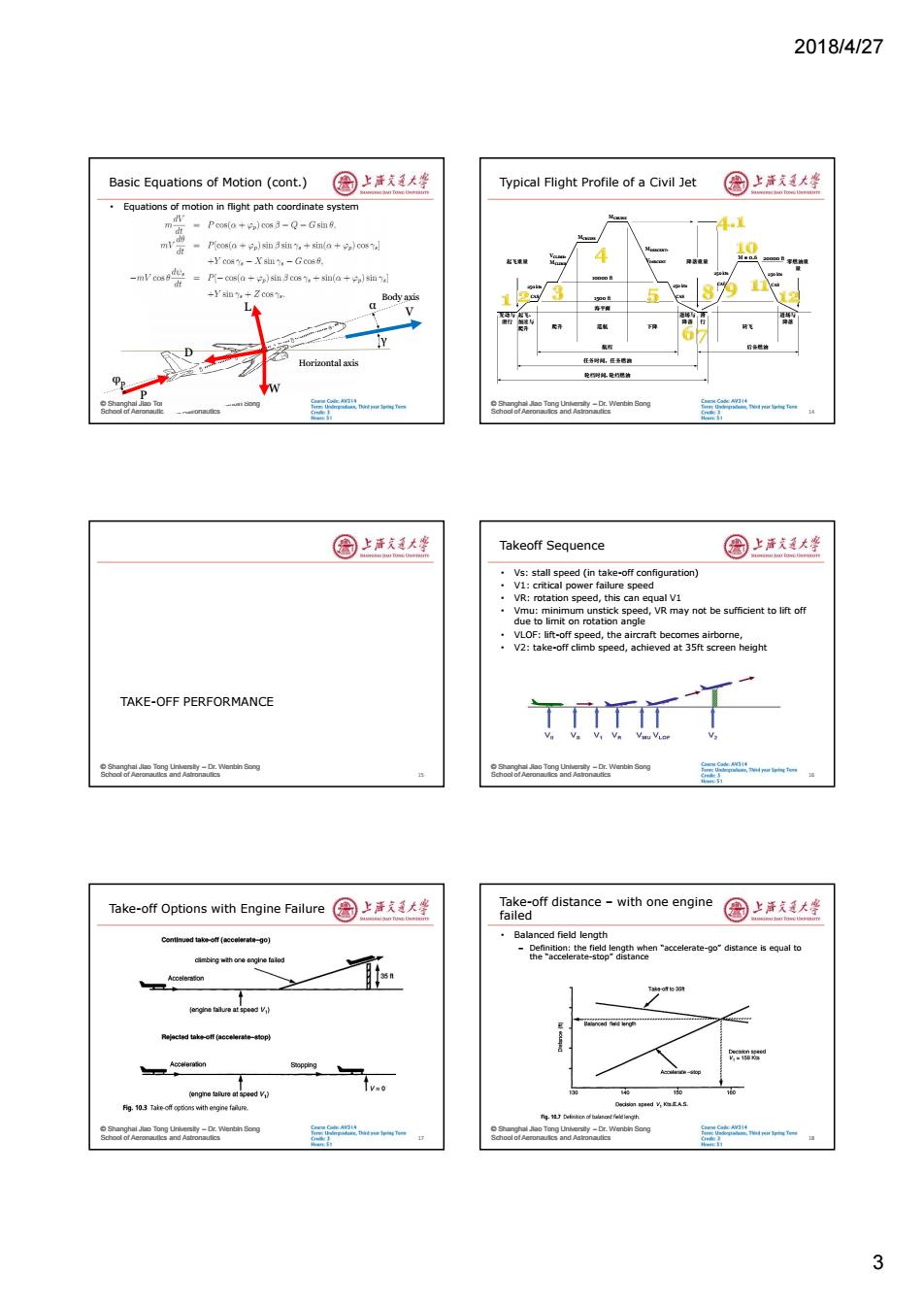
2018/4/27 Basic Equations of Motion (cont.) 园上活道大学 Typical Flight Profile of a Civil Jet 国上清大学 Equations of motion in flight path coordinate system =Poos(o +p)cos 3-Q-Gsin 8. -P严c0s(a+Cp)sin 3sin,+sin(a+》cos +Y coe%-Xsl?-Gcos8. 4 一mcos坐 P-cas(a+)sin 3cos.+sin(a+p)sin +Y'sin: Body axis F Horizontal axis 任务时间,任亮感酒 W am Song 国上清文大些 Takeoff Sequence 圆上洋廷大整 Vs:stall speed (in take-off configuration) V1:critical power failure speed VR:rotation speed,this can equal V1 Vmu:minimum unstick speed,VR may not be sufficient to lift off due to limit on rotation angle VLOF:lift-off speed,the aircraft becomes airborne V2:take-off climb speed,achieved at 35ft screen height TAKE-OFF PERFORMANCE Wertin org o Wenbin ong Take-off Options with Engine Failure 图上清文通大学 Take-off distance-with one engine failed 园上洋文大学 Balanced field length dimbingthore angine faled enaccelerate-go distance Rejected tke-off (accelerate-sop) fv-o Fig.10.Taieoff ctons withengne fare. sy-Dr.Wenbin Song 3
2018/4/27 3 © Shanghai Jiao Tong University – Dr. Wenbin Song School of Aeronautics and Astronautics Basic Equations of Motion (cont.) • Equations of motion in flight path coordinate system L D W V Horizontal axis γ α φp P Body axis © Shanghai Jiao Tong University – Dr. Wenbin Song School of Aeronautics and Astronautics Typical Flight Profile of a Civil Jet 14 250 kts CAS 发动与 滑行 起飞、 加速与 爬升 爬升 巡航 下降 进场与 降落 滑 行 进场与 降落 转飞 航程 任务时间,任务燃油 轮档时间, 轮档燃油 后备燃油 起飞重量 降落重量 零燃油重 量 10000 ft 1500 ft 海平面 20000 ft 250 kts CAS 250 kts CAS VCLIMB, MCLIMB MCRUISE MCRUISE MDESCENT, VDESCENT M = 0.6 250 kts CAS © Shanghai Jiao Tong University – Dr. Wenbin Song School of Aeronautics and Astronautics TAKE-OFF PERFORMANCE 15 © Shanghai Jiao Tong University – Dr. Wenbin Song School of Aeronautics and Astronautics Takeoff Sequence • Vs: stall speed (in take-off configuration) • V1: critical power failure speed • VR: rotation speed, this can equal V1 • Vmu: minimum unstick speed, VR may not be sufficient to lift off due to limit on rotation angle • VLOF: lift-off speed, the aircraft becomes airborne, • V2: take-off climb speed, achieved at 35ft screen height 16 © Shanghai Jiao Tong University – Dr. Wenbin Song School of Aeronautics and Astronautics Take-off Options with Engine Failure 17 © Shanghai Jiao Tong University – Dr. Wenbin Song School of Aeronautics and Astronautics Take-off distance – with one engine failed • Balanced field length – Definition: the field length when “accelerate-go” distance is equal to the “accelerate-stop” distance 18
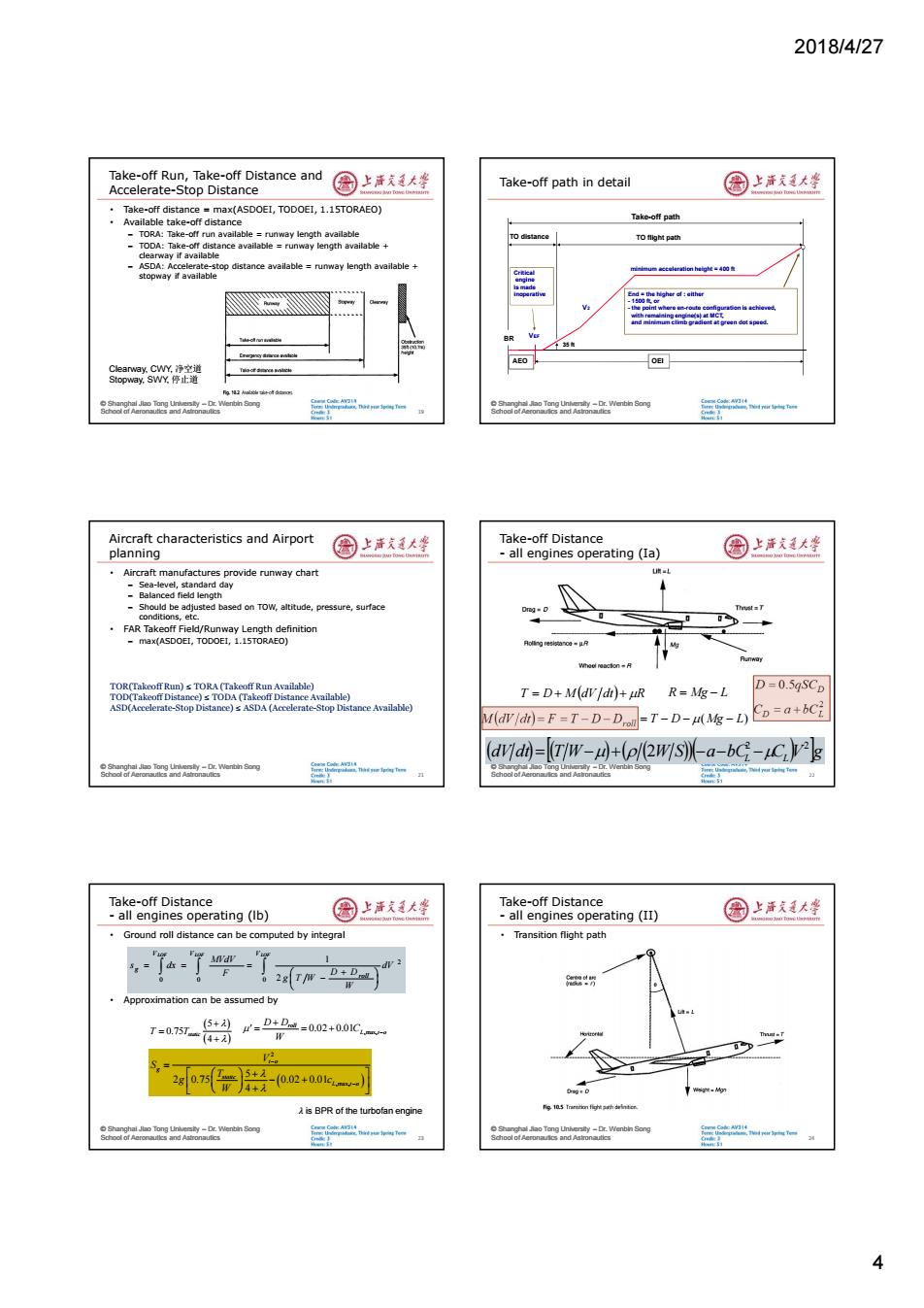
2018/4/27 Take-off Run,Take-off Distance and Take-off path in detail Accelerate-Stop Distance 因上声克通大学 国上清大学 Take-off distance max(ASDOEI,TODOEI,1.15TORAEO) Available take-off distance Take-off path TORA:Take-off run available runway length available TO ight path -TODA:Take-off distance available runway length available clearway if available ASDA:A AEO 8aoTe2e二Werbin Song Aircraft characteristics and Airport planning 圈上活大坐 Take-off Distance all engines operating (Ia) 国上活大孝 Aircraft manufactures provide runway chart U -Sea-level,standard day -Balanced field lenoth -Should be adjusted based on TOW,altitude,pressure,surface conditions.etc. FAR Takeoff Field/Runway Length definition max(ASDOEI,TODOEI,1.15TORAEO) TOR(Takeoff Run)sTORA (Takeoff Run Available) TOD(Takeoff Distance)s TODA (Takeoff Distance Available) T=D+M(dV/dt)+uR R=Mg-L D-0.5qSCp ASD(Accelerate-Stop Distance)sASDA(Accelerate-Stop Distance Available) M(dv/dn)-F=T-D-D-T-D-M(Mg-L)Cp=a+bCi (dV]d)=(T/W-)+(p/(2WJS)-a-bGi-iC.)v2g Take-off Distance Take-off Distance all engines operating (Ib) 国上洋大坐 all engines operating (II) 园上海发大坐 Ground roll distance can be computed by integral Transition flight path -d 。 Approximation can be assumed by (5+) T=0.75T “(4+2) -D+D-=0.02+01C 2 5+2 -0.02+0.01c-) is BPR of the turbofan engine sty-Dr.Wenbin Song y-Dr.Wenbin Song 4
2018/4/27 4 © Shanghai Jiao Tong University – Dr. Wenbin Song School of Aeronautics and Astronautics Take-off Run, Take-off Distance and Accelerate-Stop Distance • Take-off distance = max(ASDOEI, TODOEI, 1.15TORAEO) • Available take-off distance – TORA: Take-off run available = runway length available – TODA: Take-off distance available = runway length available + clearway if available – ASDA: Accelerate-stop distance available = runway length available + stopway if available 19 Clearway, CWY, 净空道 Stopway, SWY, 停止道 © Shanghai Jiao Tong University – Dr. Wenbin Song School of Aeronautics and Astronautics Take-off path in detail BR 35 ft TO distance TO flight path Take-off path VEF Critical engine is made inoperative AEO OEI V2 minimum acceleration height = 400 ft End = the higher of : either - 1500 ft, or - the point where en-route configuration is achieved, with remaining engine(s) at MCT, and minimum climb gradient at green dot speed. © Shanghai Jiao Tong University – Dr. Wenbin Song School of Aeronautics and Astronautics Aircraft characteristics and Airport planning • Aircraft manufactures provide runway chart – Sea-level, standard day – Balanced field length – Should be adjusted based on TOW, altitude, pressure, surface conditions, etc. • FAR Takeoff Field/Runway Length definition – max(ASDOEI, TODOEI, 1.15TORAEO) 21 TOR(Takeoff Run) ≤ TORA (Takeoff Run Available) TOD(Takeoff Distance) ≤ TODA (Takeoff Distance Available) ASD(Accelerate-Stop Distance) ≤ ASDA (Accelerate-Stop Distance Available) © Shanghai Jiao Tong University – Dr. Wenbin Song School of Aeronautics and Astronautics Take-off Distance - all engines operating (Ia) 22 T D M dV dt R R Mg L M dV dt F T D D T D (Mg L) roll D D 0.5qSC 2 D L C a bC dV dt T W W S a bCL CLV g 2 2 2 © Shanghai Jiao Tong University – Dr. Wenbin Song School of Aeronautics and Astronautics Take-off Distance - all engines operating (lb) • Ground roll distance can be computed by integral • Approximation can be assumed by 23 LOF LOF V LOF roll V V g dV W D D g T W F MVdV s dx 0 2 0 0 2 1 5 0.75 4 T Tstatic L t o roll C W D D ,max, 0.02 0.01 2 ,max, 5 2 0.75 0.02 0.01 4 t o g static L t o V S T g c W 𝜆 is BPR of the turbofan engine © Shanghai Jiao Tong University – Dr. Wenbin Song School of Aeronautics and Astronautics Take-off Distance - all engines operating (II) • Transition flight path 24
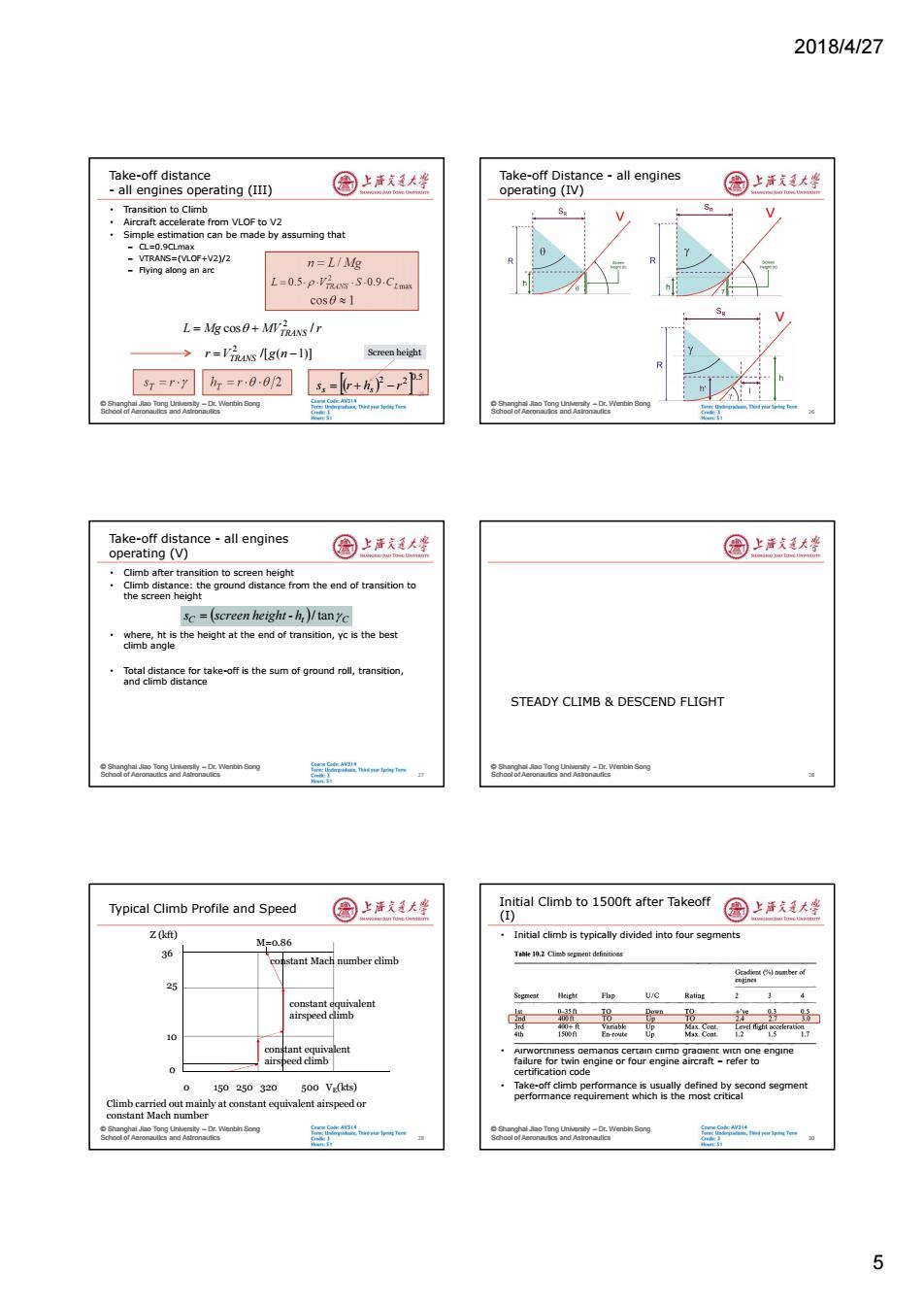
2018/4/27 Take-off distance 园上注庆大坐 Take-off Distance all engines all engines operating (III) operating (IV) 国上清大学 Transition to Climb Aircraft accelerate from VLOF to V2 Simple estimation can be made by assuming that -▣=0g□ma¥ -VTRANS=(VLOF+V2)/2 -Flying along an arc n=L/Mg 1=0.5-p-Vs5-0.9.Cima cos0≈1 L=Mg cos0+MVjmus/r r='g(-l月 Screen height ST=ry hr=r00/2 =G+-2 ong Take-off distance-all engines operating (V) 国上活大坐 国上活文大蜂 Climb after transition to screen height Climb distance:the ground distance from the end of transition to the screen height sc=(screen height-h)/tanyc where,ht is the height at the end of transition,yc is the best climb angle Total distance for take-off is the sum of ground roll,transition, and climb distance STEADY CLIMB DESCEND FLIGHT oon Wenbn ong Typical Climb Profile and Speed 图上洋大峰 Initial Climb to 1500ft after Takeoff (I) 国上洋大学 Z0) M=0.86 Initial climb is typically divided into four segments 36 constant Mach number climb Tahlemsement definitioes U/C Rating 4 constant equivalent airspeed climb En-route Up 0 0 150250320 500 Vg(kts) Take-off climb performance is usually defined by second segment performance requirement which is the most critical Climb carried out mainly at constant equivalent airspeed or constant Mach number y-Dr.Wenbin Song 5
2018/4/27 5 © Shanghai Jiao Tong University – Dr. Wenbin Song School of Aeronautics and Astronautics Take-off distance - all engines operating (III) • Transition to Climb • Aircraft accelerate from VLOF to V2 • Simple estimation can be made by assuming that – CL=0.9CLmax – VTRANS=(VLOF+V2)/2 – Flying along an arc 25 L Mg MV r TRANS cos / 2 n L / Mg max 2 L 0.5 VTRANS S 0.9 CL /[ ( 1)] 2 r VTRANS g n cos 1 s r T h r 2 T 0.5 2 2 s r h r s s Screen height © Shanghai Jiao Tong University – Dr. Wenbin Song School of Aeronautics and Astronautics Take-off Distance - all engines operating (IV) 26 © Shanghai Jiao Tong University – Dr. Wenbin Song School of Aeronautics and Astronautics Take-off distance - all engines operating (V) • Climb after transition to screen height • Climb distance: the ground distance from the end of transition to the screen height • where, ht is the height at the end of transition, γc is the best climb angle • Total distance for take-off is the sum of ground roll, transition, and climb distance 27 C t C s screen height - h / tan © Shanghai Jiao Tong University – Dr. Wenbin Song School of Aeronautics and Astronautics STEADY CLIMB & DESCEND FLIGHT 28 © Shanghai Jiao Tong University – Dr. Wenbin Song School of Aeronautics and Astronautics Typical Climb Profile and Speed 29 Climb carried out mainly at constant equivalent airspeed or constant Mach number constant Mach number climb 0 150 250 320 500 VE (kts) Z (kft) 36 25 10 0 constant equivalent airspeed climb constant equivalent airspeed climb M=0.86 © Shanghai Jiao Tong University – Dr. Wenbin Song School of Aeronautics and Astronautics Initial Climb to 1500ft after Takeoff (I) • Initial climb is typically divided into four segments • Airworthiness demands certain climb gradient with one engine failure for twin engine or four engine aircraft – refer to certification code • Take-off climb performance is usually defined by second segment performance requirement which is the most critical 30